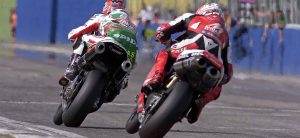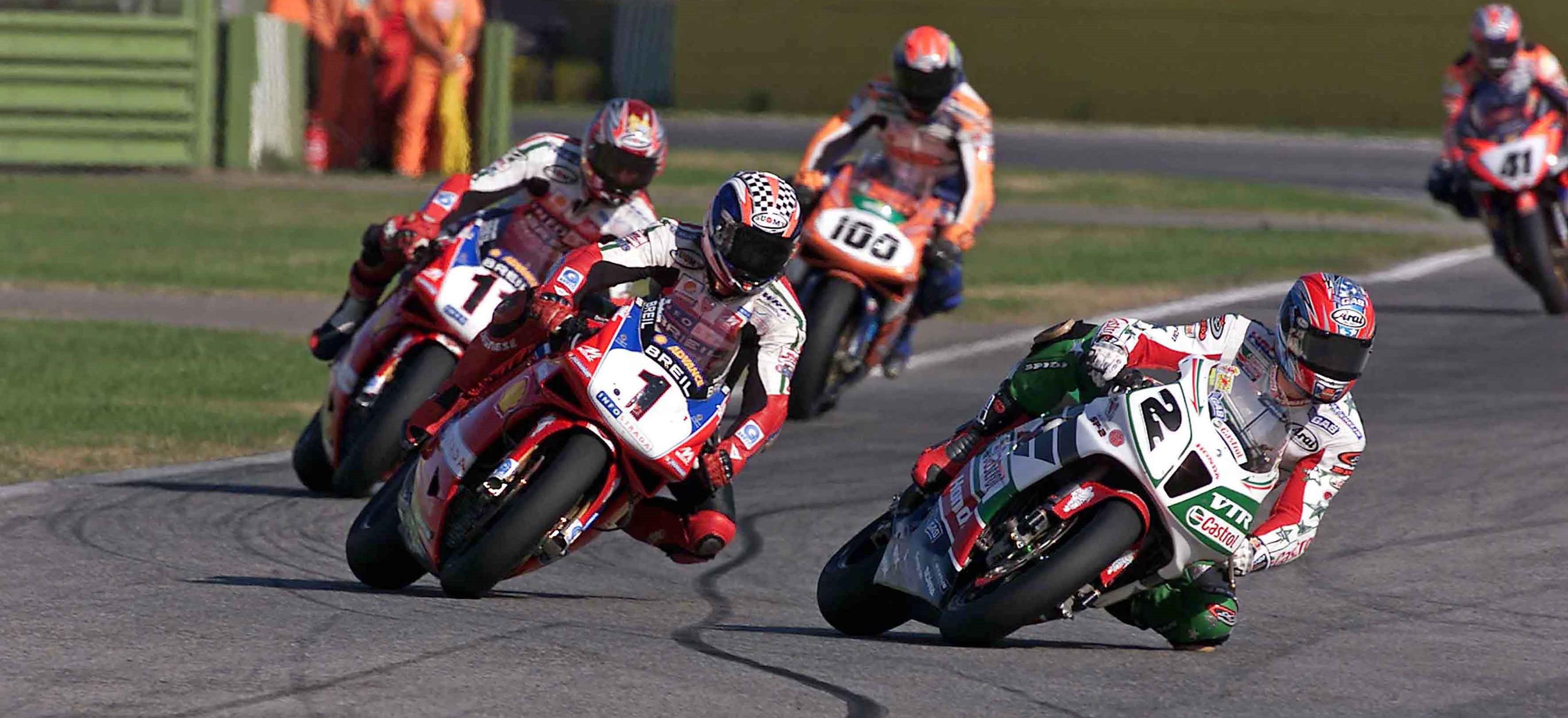September 29, 2002. The Superbike World Championship headed to the classic Imola circuit in Italy, to crown a champion at the end of an extraordinary season and, as it would turn out, an extraordinary era.
The second Imola 2002 race in particular was iconic, famous for the bar-to-bar battle between Troy Bayliss and Colin Edwards, two greats of a golden era of superbike racing, each going for what would be their second world title.
The season had been one of devastation by the top two riders and, to quote the football cliché, a game of two halves.
Reigning champion Bayliss had dominated the early part of the season, taking doubles at the first three rounds and winning 14 of the first 17 races to lead the consistent Edwards by 58 points going into race two at the American’s home round, at Laguna Seca.
What happened next was a remarkable turnaround rarely seen in any sport. Edwards went on to win the next seven races in a row. Combined with the crash for Bayliss in Assen, the Texas Tornado blew into the Imola finale with a single point advantage.

Race one was full of drama. Edwards bolted into a lead but was being reeled in by Bayliss when the red flags came out on lap 11, due to a crash involving Neil Hodgson. At the time, two part races were determined by aggregate results and in the restart the Honda man did what he needed to do to take the win, sitting behind the Ducati rider to take the overall win.
That win extended Edwards’ lead to six points, meaning he just needed to finish second to Bayliss to take the title. The Ducati man that he needed to win the race and get another rider between himself and Edwards, and what followed was a thrilling battle between the two.
Bayliss hit the front, with Hodgson (signed up to replace him in the factory team for 2003) holding off Edwards in the opening laps. By the third lap Edwards had made it through to the front and tried to stretch a lead, but Bayliss showed true grit to fight back into the lead, where he tried to slow the pace down in order to get team-mate Ruben Xaus and Hodgson into the fight. Xaus was able to get within half a second of the front two and the Honda team had their hearts in their mouths as Bayliss made some charging passes on the final lap.
In the end, Edwards took the win and the title after a Bayliss had a big slide a few laps from home. The domination had repercussions though. Despite riders like Hodgson, Noriyuki Haga and Ben Bostrom on the grid, only one other rider won a race all season. That was Makota Tamada, won his home round as a wild-card at Sugo, a not unexpected result, on another factory Honda.
Tamada’s win was also the only one for a rider on Dunlop tyres, and it was the first year in the history of the championship where all races were won by 1000cc V-twins, as the 750cc fours spent the year chasing shadows. These two factors were to change the face of superbike racing in the immediate years to come.
Alongside that, the introduction of the new four-stroke MotoGP rules saw an exodus of riders and manufacturers to the prototype class. Four-strokes had been introduced alongside 500cc two-strokes in 2002, but from 2003 the grid was almost exclusively four-stroke and took with it the prime pickings of the superbike paddock.
Yamaha had already abandoned their superbike project at the end of 2000, to divert resources to their YZR-M1 MotoGP bike and Aprilia, Honda and Kawasaki bowed out after Imola 2002, to increase their Grand Prix presence.
Three of the top four superbike riders also went to MotoGP, Edwards and Haga joined Aprilia and attempted to tame the firebreathing RS3 Cube, while Bayliss linked up with Loris Capirossi for Ducati’s high profile MotoGP debut.
The result was a much less vibrant superbike paddock for 2003. Rules had been allowed changed to allow 1000cc fours, which were now commonplace in the showrooms, to compete alongside the 750cc fours and 1000cc twins, albeit with an air restrictor to create parity, but only Gregorio Lavilla on the Alstare Suzuki GSX-R1000 managed to put one on the podium.
Indeed, the Spaniard was the only non Ducati in the top 10 of the final standings – fifth overall – and the series was once again a case of the haves and the have nots.
Edwards had been 226 points ahead of third placed Hodgson when he won the title in 2002, and Hodgy strolled to a 113 point win over Xaus the following year, with third placed James Toseland 228 points behind the champion.
Those third placed finishers were relevant because they were the first Dunlop shod runners in the championship or, more relevantly, the top non-Michelin riders.
While groans of a perceived advantage for the V-twins had been grumbling since the very beginning of the series in 1988, the unfairness of tyre allocations was the talk of the town as the new millennium arrived. Michelin riders had won the title every year since 1994 and although the practice of allocating the best tyres to certain riders had always happened, the Dunlop teams had generally always been able to fight for wins at certain tracks and remain competitive in the championship.
The French company’s practice of only making its very special tyres available to Honda and Ducati’s works teams in 2002 led to frustration from the other outfits, who still had to pay top dollar for inferior product. In 2003, the official Ducatis of Hodgson and Xaus were the only factory Michelin riders and again romped to the title. This led to the introduction of Pirelli as a single tyre manufacturer for 2004, giving all teams access to the exact same rubber at a reduced cost.
These days, almost every car or bike racing series has a control tyre for the exact same reasons but, at the time, it was an unprecedented move and despite bringing parity, it also brought cries from purists who felt that it diminished the series’ status as a leading world championship.
Whether it did or didn’t in itself will never really be known, as it happened at a time of great change for bike racing, but all of those changes arguably helped world superbikes reinvent itself. MotoGP, which had been on the brink little more than a decade earlier, went into the stratosphere, given a shot in the arm by a grid full of exotic new bikes and fuelled by the rise in Rossimania.
It could be argued that superbike went through something of a fallow period in the mid 2000s, but not for long. Four cylinder machines came back into the ascendency and factory supported teams returned in 2005. By 2009, Ducati remained the manufacturer to beat, but all four Japanese manufacturers had a strong presence and were joined by full factory efforts from Aprilia and BMW.
Today the championship still races at Imola each year but is virtually indistinguishable from the series of 2002. All teams now use 1000cc four cylinder machines, and Pirelli remains the sole tyre manufacturer. Kawasaki and Jonathan Rea have been the dominant force for the past five years, but with full factory teams from Ducati and Honda as well as very competitive supported squads from BMW and Yamaha, the series remains in rude health as it looks to enter another golden era.
Pictures: Honda Pro Racing



